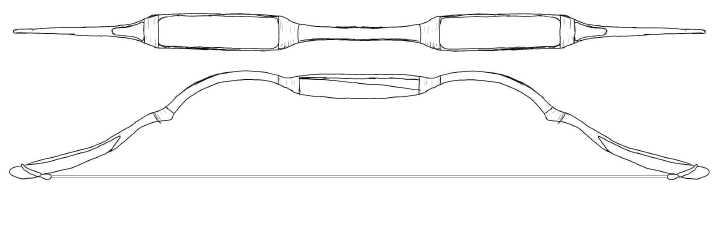Culture : Scythian
Period : 3rd 1st century B.C. (?)
Material : Bamboo, wood, leather, iron (arrowheads)
Dimensions : L: 93.1 cm
Ex-American private collection.
Conditions : Panoply including a complete bow (except for the catgut) in excellent condition, arrows with metal heads and a wooden quiver entirely covered with leather straps still retaining their original bright colors (green/blue, green/brown, red, black, white) and decoration.
This set is exceptional for both its rarity and its remarkable state of preservation. The bow, which is composed of a bamboo limb, has the typical Σ-shape profi le of Scythian examples, with a slightly curved central handgrip and tips curled away from the archer for attaching the bowstring. At the tips, which had to withstand considerable stress, the wood is reinforced by a covering, probably in leather, made of a long strap tightly wrapped around the limb. A very fine and precise geometric decoration, incorporating circles, lozenges, squares, triangles, lines, etc., is engraved inside the bow, just before the tips; it is comprised of small plaques made of an unknown material (wood, leather?). The arrows each have a wooden shaft, on which is mounted a long, thin metal arrowhead in the shape of a leaf with a slender or more rounded outline; at the back of each arrow, there are still traces of the fletching (which, in the known Scythian specimens, was made of bird feathers). The quiver has a triangular section that narrows towards the bottom; it is made of pale wooden boards held by pegs and covered by a thin layer of white leather. Wide colored leather bands decorate the quiver; these bands are adorned with wild animals, among which one can identify horses and deer, alternating with geometric patterns and garlands of leaves and flowers.
The type of composition and the style are definitely related to Scythian representations. The Scythians lived in regions (a wide area ranging from the Danubian Plains to the Asian and Siberian steppes) that were characterized by a dry and very cold climate, a fact that exceptionally enabled the preservation of unusual objects made of perishable materials such as wood, fabric or, like here, painted leather. As often evidenced in Scythian iconography, activities connected to the world of weapons were the most important male occupations in the Scythian tribes; both in war and hunting scenes and in images of rest, men are always depicted with their weapons within reach. With other luxury items, weapons of course accompanied their owner in the tomb. Unlike the Greek conception of war, which was based on the close combat of phalanxes of infantrymen representing the various cities (bows were barbaric weapons to the Greeks), the bow was the key piece in the equipment of these nomadic warriors. Rather small (about 60-80 cm long), but very handy and eff ective, it could be used on horseback or on foot, for hunting or for long-range combat. Even in the scenes of rest, Scythians always keep their bow in the case slung from their belt or hanging from a tree nearby. Among the most famous Scythian scenes, one should mention the relief of the electrum goblet from Kul-Oba representing a bearded man drawing his bow. Moreover, it is certainly no coincidence that in Classical Athens, the police force was made up of Scythian slaves, each always armed with a bow, a sword and/or an axe. Aside from a later set found in a tomb in the Northern Caucasus (Moschevaya Balka, 8th century A.D.), which includes a bow, a quiver and arrows, typologically very different and certainly less luxurious, no other ancient bow can be mentioned as a parallel to this object. In an area further north, but still in Western Asia, in the plain of the Oxus, a group of miniature votive weapons made of gold and silver was discovered in a temple in Takhti-Sangin; this treasure, dated to between the 5th and the 2nd century B.C., includes many bows of the Scythian type, arrows, spears, swords, etc.
Bibliography
On Scythians and war, see:
LEBEDYNSKY I., Les Scythes: La civilisation des steppes, Paris, 2001, pp. 154 ff. L’or des Scythes: Trésors de l’Ermitage, Leningrad, Brussels, 1991, no. 57 (goblet from Kul-Oba, Kerch).
On ancient bows, see:
Treasures of Ancient Bactria, Tokyo, 1991, pp. 242 ff., nos. 90-96 (miniature votive weapons). The Treasures of Nomadic Tribes in South Russia, Tokyo, 1991, p. 152, nos. 205-206 (wooden bow and quiver dated to the 8th century A.D., from Moschevaya Balka, Northern Caucasus).

